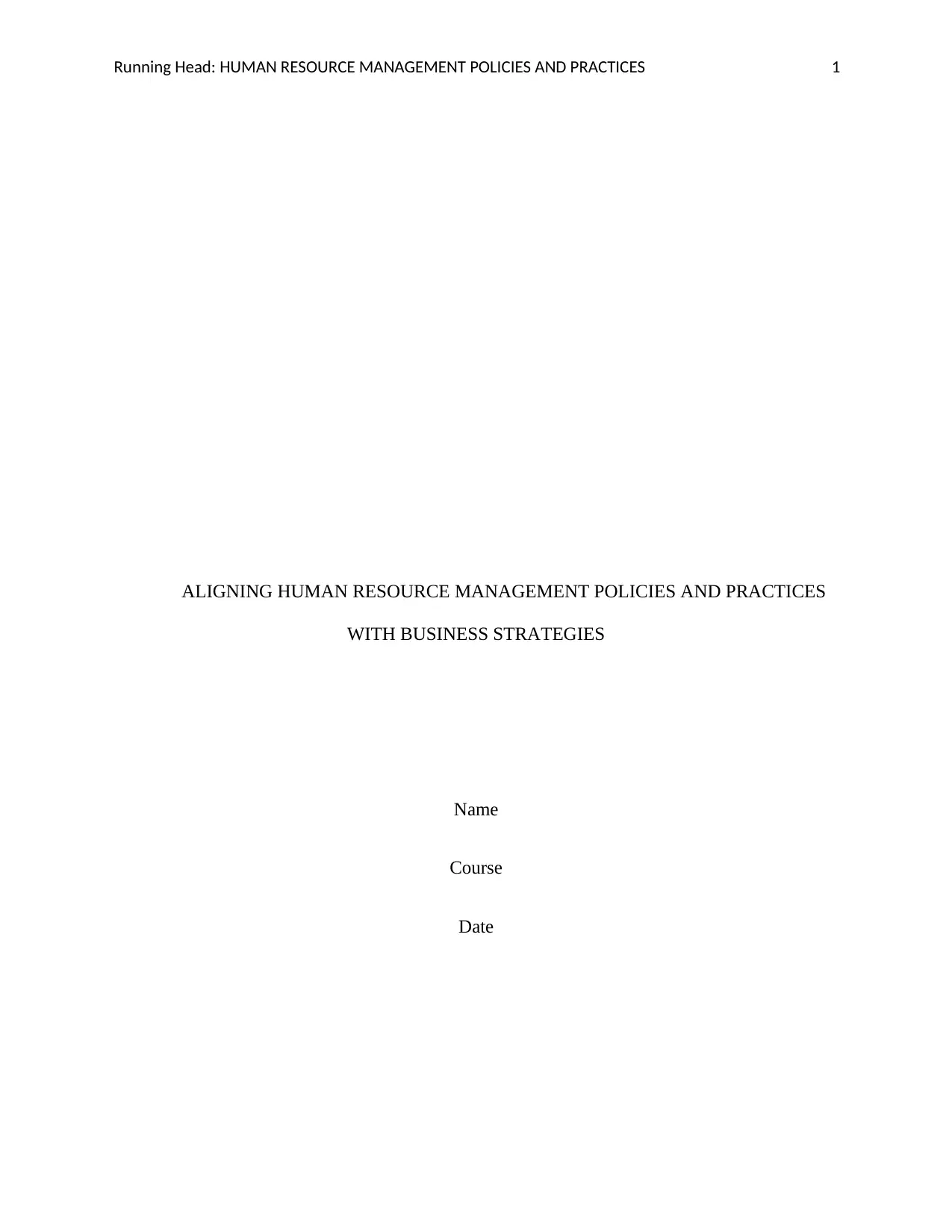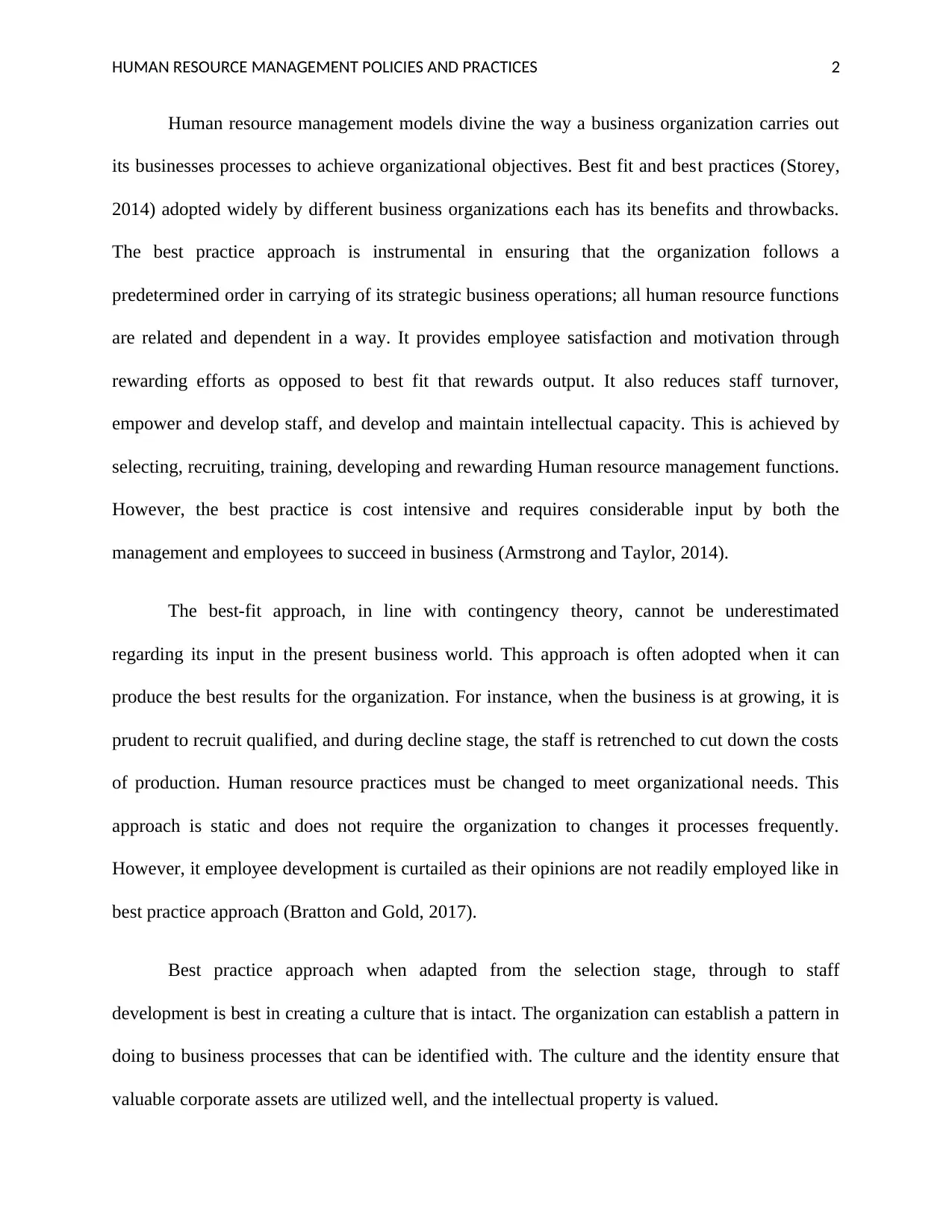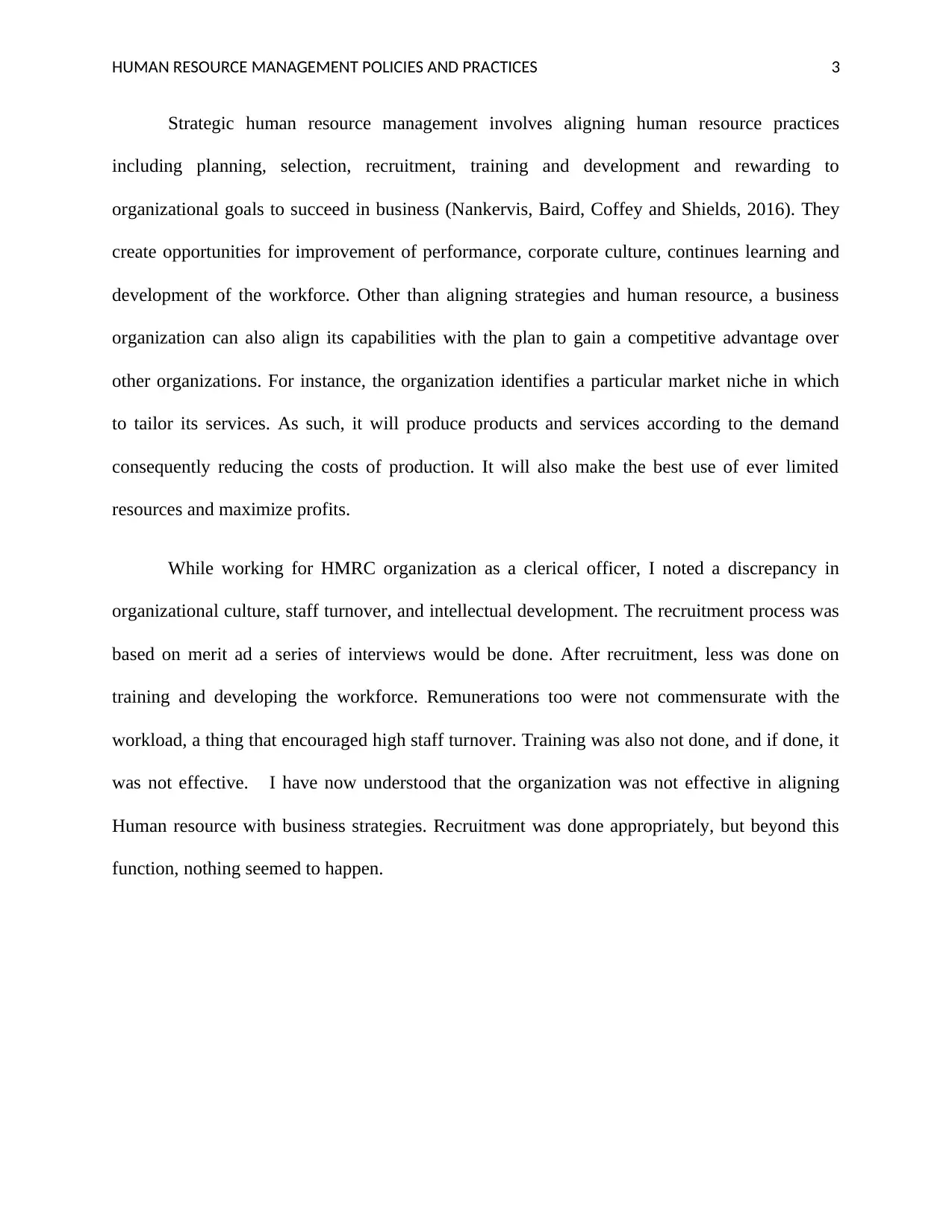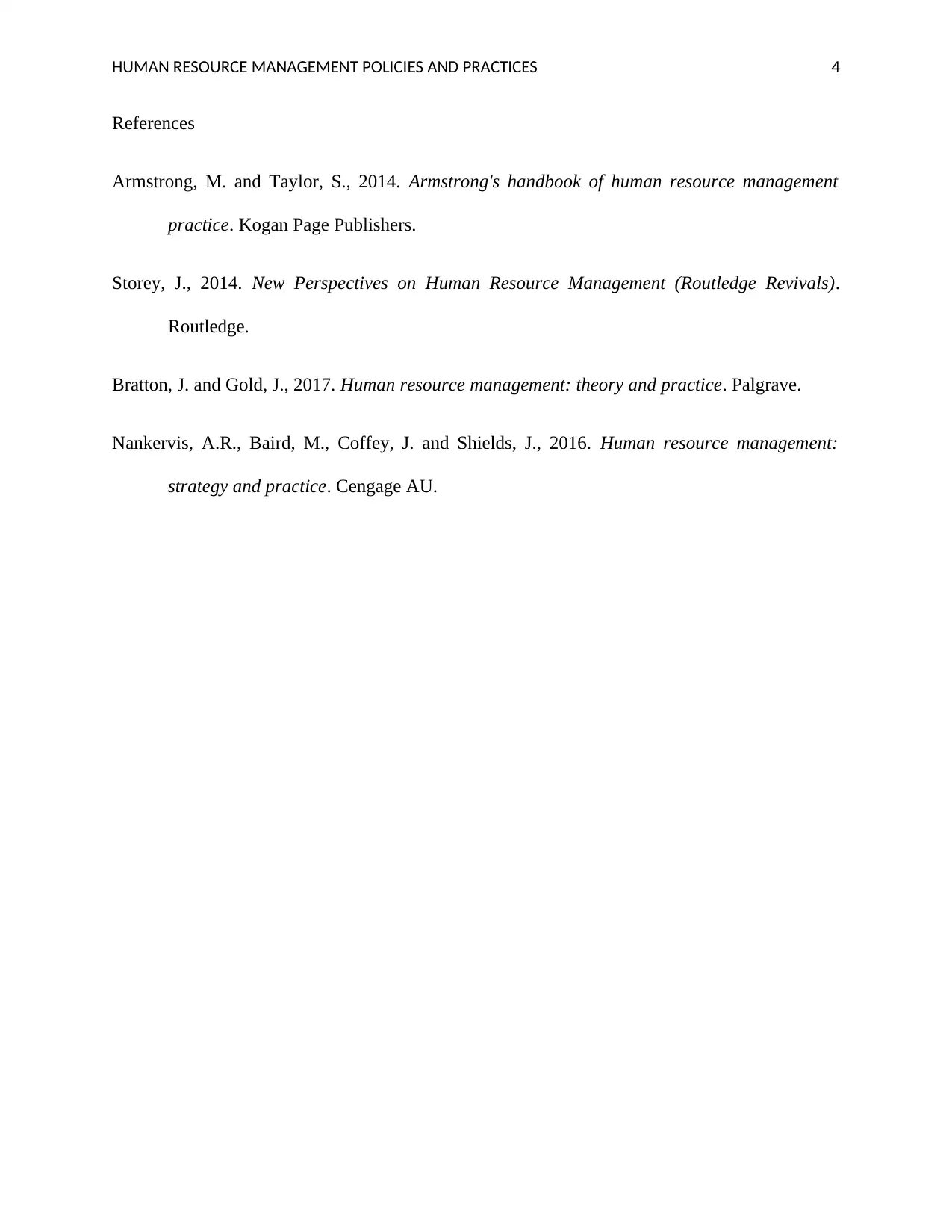Aligning Human Resource Management Policies and Business Goals
VerifiedAdded on 2023/06/03
|4
|745
|450
Essay
AI Summary
This essay discusses the alignment of Human Resource Management (HRM) policies and practices with business strategies, comparing the best-fit and best-practice approaches. It highlights the importance of aligning HRM functions such as planning, selection, recruitment, training, development, and rewards with organizational goals to improve performance and corporate culture. The author reflects on their experience at HMRC, noting discrepancies in organizational culture, staff turnover, and intellectual development due to a lack of alignment between HRM practices and business strategies. The essay concludes by emphasizing the need for organizations to strategically integrate HRM with their overall business objectives for sustained success.

Running Head: HUMAN RESOURCE MANAGEMENT POLICIES AND PRACTICES 1
ALIGNING HUMAN RESOURCE MANAGEMENT POLICIES AND PRACTICES
WITH BUSINESS STRATEGIES
Name
Course
Date
ALIGNING HUMAN RESOURCE MANAGEMENT POLICIES AND PRACTICES
WITH BUSINESS STRATEGIES
Name
Course
Date
Paraphrase This Document
Need a fresh take? Get an instant paraphrase of this document with our AI Paraphraser

HUMAN RESOURCE MANAGEMENT POLICIES AND PRACTICES 2
Human resource management models divine the way a business organization carries out
its businesses processes to achieve organizational objectives. Best fit and best practices (Storey,
2014) adopted widely by different business organizations each has its benefits and throwbacks.
The best practice approach is instrumental in ensuring that the organization follows a
predetermined order in carrying of its strategic business operations; all human resource functions
are related and dependent in a way. It provides employee satisfaction and motivation through
rewarding efforts as opposed to best fit that rewards output. It also reduces staff turnover,
empower and develop staff, and develop and maintain intellectual capacity. This is achieved by
selecting, recruiting, training, developing and rewarding Human resource management functions.
However, the best practice is cost intensive and requires considerable input by both the
management and employees to succeed in business (Armstrong and Taylor, 2014).
The best-fit approach, in line with contingency theory, cannot be underestimated
regarding its input in the present business world. This approach is often adopted when it can
produce the best results for the organization. For instance, when the business is at growing, it is
prudent to recruit qualified, and during decline stage, the staff is retrenched to cut down the costs
of production. Human resource practices must be changed to meet organizational needs. This
approach is static and does not require the organization to changes it processes frequently.
However, it employee development is curtailed as their opinions are not readily employed like in
best practice approach (Bratton and Gold, 2017).
Best practice approach when adapted from the selection stage, through to staff
development is best in creating a culture that is intact. The organization can establish a pattern in
doing to business processes that can be identified with. The culture and the identity ensure that
valuable corporate assets are utilized well, and the intellectual property is valued.
Human resource management models divine the way a business organization carries out
its businesses processes to achieve organizational objectives. Best fit and best practices (Storey,
2014) adopted widely by different business organizations each has its benefits and throwbacks.
The best practice approach is instrumental in ensuring that the organization follows a
predetermined order in carrying of its strategic business operations; all human resource functions
are related and dependent in a way. It provides employee satisfaction and motivation through
rewarding efforts as opposed to best fit that rewards output. It also reduces staff turnover,
empower and develop staff, and develop and maintain intellectual capacity. This is achieved by
selecting, recruiting, training, developing and rewarding Human resource management functions.
However, the best practice is cost intensive and requires considerable input by both the
management and employees to succeed in business (Armstrong and Taylor, 2014).
The best-fit approach, in line with contingency theory, cannot be underestimated
regarding its input in the present business world. This approach is often adopted when it can
produce the best results for the organization. For instance, when the business is at growing, it is
prudent to recruit qualified, and during decline stage, the staff is retrenched to cut down the costs
of production. Human resource practices must be changed to meet organizational needs. This
approach is static and does not require the organization to changes it processes frequently.
However, it employee development is curtailed as their opinions are not readily employed like in
best practice approach (Bratton and Gold, 2017).
Best practice approach when adapted from the selection stage, through to staff
development is best in creating a culture that is intact. The organization can establish a pattern in
doing to business processes that can be identified with. The culture and the identity ensure that
valuable corporate assets are utilized well, and the intellectual property is valued.

HUMAN RESOURCE MANAGEMENT POLICIES AND PRACTICES 3
Strategic human resource management involves aligning human resource practices
including planning, selection, recruitment, training and development and rewarding to
organizational goals to succeed in business (Nankervis, Baird, Coffey and Shields, 2016). They
create opportunities for improvement of performance, corporate culture, continues learning and
development of the workforce. Other than aligning strategies and human resource, a business
organization can also align its capabilities with the plan to gain a competitive advantage over
other organizations. For instance, the organization identifies a particular market niche in which
to tailor its services. As such, it will produce products and services according to the demand
consequently reducing the costs of production. It will also make the best use of ever limited
resources and maximize profits.
While working for HMRC organization as a clerical officer, I noted a discrepancy in
organizational culture, staff turnover, and intellectual development. The recruitment process was
based on merit ad a series of interviews would be done. After recruitment, less was done on
training and developing the workforce. Remunerations too were not commensurate with the
workload, a thing that encouraged high staff turnover. Training was also not done, and if done, it
was not effective. I have now understood that the organization was not effective in aligning
Human resource with business strategies. Recruitment was done appropriately, but beyond this
function, nothing seemed to happen.
Strategic human resource management involves aligning human resource practices
including planning, selection, recruitment, training and development and rewarding to
organizational goals to succeed in business (Nankervis, Baird, Coffey and Shields, 2016). They
create opportunities for improvement of performance, corporate culture, continues learning and
development of the workforce. Other than aligning strategies and human resource, a business
organization can also align its capabilities with the plan to gain a competitive advantage over
other organizations. For instance, the organization identifies a particular market niche in which
to tailor its services. As such, it will produce products and services according to the demand
consequently reducing the costs of production. It will also make the best use of ever limited
resources and maximize profits.
While working for HMRC organization as a clerical officer, I noted a discrepancy in
organizational culture, staff turnover, and intellectual development. The recruitment process was
based on merit ad a series of interviews would be done. After recruitment, less was done on
training and developing the workforce. Remunerations too were not commensurate with the
workload, a thing that encouraged high staff turnover. Training was also not done, and if done, it
was not effective. I have now understood that the organization was not effective in aligning
Human resource with business strategies. Recruitment was done appropriately, but beyond this
function, nothing seemed to happen.
⊘ This is a preview!⊘
Do you want full access?
Subscribe today to unlock all pages.

Trusted by 1+ million students worldwide

HUMAN RESOURCE MANAGEMENT POLICIES AND PRACTICES 4
References
Armstrong, M. and Taylor, S., 2014. Armstrong's handbook of human resource management
practice. Kogan Page Publishers.
Storey, J., 2014. New Perspectives on Human Resource Management (Routledge Revivals).
Routledge.
Bratton, J. and Gold, J., 2017. Human resource management: theory and practice. Palgrave.
Nankervis, A.R., Baird, M., Coffey, J. and Shields, J., 2016. Human resource management:
strategy and practice. Cengage AU.
References
Armstrong, M. and Taylor, S., 2014. Armstrong's handbook of human resource management
practice. Kogan Page Publishers.
Storey, J., 2014. New Perspectives on Human Resource Management (Routledge Revivals).
Routledge.
Bratton, J. and Gold, J., 2017. Human resource management: theory and practice. Palgrave.
Nankervis, A.R., Baird, M., Coffey, J. and Shields, J., 2016. Human resource management:
strategy and practice. Cengage AU.
1 out of 4
Related Documents
Your All-in-One AI-Powered Toolkit for Academic Success.
+13062052269
info@desklib.com
Available 24*7 on WhatsApp / Email
![[object Object]](/_next/static/media/star-bottom.7253800d.svg)
Unlock your academic potential
Copyright © 2020–2025 A2Z Services. All Rights Reserved. Developed and managed by ZUCOL.





